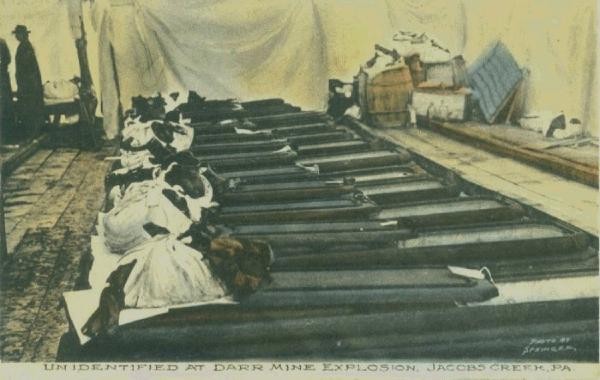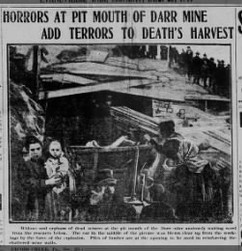The Darr Mine Disaster
Introduction
Text-to-speech Audio
On December 19th, 1907, one of the worst mining explosions occurred in Western Pennsylvania, the Darr Mine Disaster. In the Darr Mine Disaster, 239 men and young boys were killed and later laid to to rest. This explosion took place in Rostraver Township, just miles from Smithton, PA. The Darr Mine Disaster is said to be caused by miners carrying open flames through "off-limit" areas. Many innocent lives were lost because of poor judgement and failure of proper protocol. However, the Pittsburgh Coal Company was never held accountable for this deadly explosion, but rather banned the use of open flames when doing active work. There is a memory marker available to visit at the intersection of Pennsylvania Route 81 and Van Meter Road, located at the Olive Branch Baptist Church Cemetery.
Images
Unidentified Corpses at Darr Mine Disaster

U.S. Coal Mining’s Deadliest Month: December 1907

Backstory and Context
Text-to-speech Audio
In the 19th century, the coal industry became the most popular way to source energy for most of the United States; this included steam engines, furnaces, and forges. It was a raving industry during this time. For the men working in the mines, this was a difficult life to lead. The working conditions were dark, filthy, and incredibly unsafe. The Darr Mine Disaster, was one of the worst mine explosions to happen in Pennsylvania, leaving around 250 men and young boys deceased.
A career in coal mining was easy to secure due to the high demand for coal at the time, it was especially an easy way for immigrants to support their families. The conditions, however, were not ideal. On the average day a miner would work about 10-hour days, with the pay rate of $1.70 an hour. The mines were dangerous in various ways; miners could expect to be crushed, inhaling toxic gases, and were threatened by fires and explosions. Miners risked their health and safety daily to be able to support themselves and their families.
In Western Pennsylvania, coal mining activity peaked during the late 19th century. The Pittsburgh Coal Field was the largest coalfield in Western PA at the time; it included parts of Greene, Allegheny, Fayette, and Westmoreland counties since the late 18th century. During this time, mining relied on purely manual labor. Miners had to manually cut the coal; while horse and wagon hauled the coal to the transport field. Consequently, the demand for coal grew higher when the population of Western PA suddenly grew.
The Darr Mine Disaster of 1907, is said to be one of the worst mining disasters to happen in the United States. On December 19th of 1907; an inspection of the Van Meter coal mine was supposed to take place, and someone failed to do so. According to multiple sources, a handful of miners had gone into "off-limit" area with heaps of coal dust and poor ventilation with opened flames. The possible cause of this disaster was a large amount of dynamite that was lit in the "off-limit" areas. Due to the lack of safety protocol and supposed inspection of the mine, there were 250 fatalities this day. With better safety conditions and protocol; there is a possibility this disaster could have been prevented.
Mining conditions have drastically changed since the Darr Mine Disaster. Due to technological advances in mining equipment, miners now have more room to stand and move around. Along with these technological advances, miners and their higher ups are required to carry two forms of technological communication on them while they are actively working. Along with, high intensity rescue training programs and technology to quickly attend to miners in danger. Miners are completely aware of the many things that can happen in this career; but they continue to do the work.
In conclusion, mining is known to be very dangerous, during the 19th century era this was the only option for so many men. Today with new technology and stricter safety conditions; miners can have a much better chance to not get injured. Unfortunately, the lives taken in the Darr Mine Disaster were not as lucky to receive these conditions.
Cite This Entry
Anna C. Pilla . "The Darr Mine Disaster." Clio: Your Guide to History. May 3, 2022. Accessed March 31, 2025. https://theclio.com/entry/148343
Sources
1. United Press Dispatch, December 20, 1907, http://explorepahistory.com/odocument.php?docId=1-4-178.
2. Isabella Grullon Paz, Janurary 8, 2022 https://www.nytimes.com/2022/01/08/us/mine-collapse-pennsylvania-fayette-county.html.
3. National Coal Heritage Area & Coal Heritage Trail https://coalheritage.wv.gov/coal_history/Pages/Coal-Miners.aspx.
4. Ackerman, Daniel J. “The Darr Mine Disaster.” Westmoreland History 18, no. 2 (Winter2013/2014 2013): 4–9. https://search.ebscohost.com/login.aspx?direct=true&AuthType=ip,sso&db=edo&AN=94091344&site=eds-live.
5. Darr mine relief committee. Darr Mine Relief Fund Report to the Executive Committee: Covering the Collection and Distribution of the Public Fund for the Dependents of the Men Killed by the Explosion in the Darr Mine of the Pittsburgh Coal Company, December 19th, 1907. [Pittsburg?, 1910. https://search.ebscohost.com/login.aspx?direct=true&AuthType=ip,sso&db=edshlc&AN=edshlc.004537828.2&site=eds-live.
Toth, Anna. Unidentified Corpses at Darr Mine Explosion, Westmoreland County, PA, December 1907. Jacobs Creek, PA. http://explorepahistory.com/displayimage.php?imgId=1-2-DEC
Hammond, Trevor. U.S. Coal Mining's Deadliest Month: December 1907. https://blog.newspapers.com/u-s-coal-minings-deadliest-month-december-1907/

